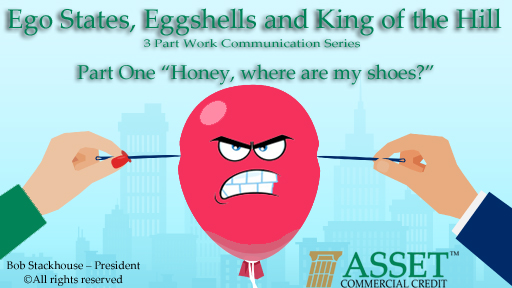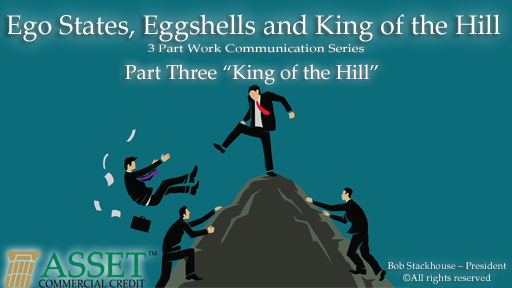Have you ever learned something that empowered you to help others throughout you career? I’ve gathered a few gems from my past and will offer them in a quick, easy to read series designed to help with managing people.
12 Tips for working from home
First, a few words about the times. Bad things are happening to many (a gross understatement). My prayers are with all who Covid-19 has impacted, their families and the health care workers who are witnessing tragedy every day
Ego States, Eggshells and King of the Hill- Part three: “King of the Hill”
Have you ever learned something that empowered you to help others throughout you career? Sharing stories is the focus of this series. Here is another gem from my past designed to help with managing people. This core concept/analogy has also been used many times to help employees and friends who are having issues with others to find a productive path to solving their own communication issues. This next one is about power, authority and control. You all remember (though perhaps not) that a common game kids play is King of the Hill (find a three-foot mound and try to stay on top while your friend tries to physically knock you off then they take your place). You might have played tag, dodge ball or some other competitive game. A question to ponder is: are kids naturally competitive or do we teach them to be competitive? Personally, I think humans are naturally competitive. You just have to look at sports to see competition that is not limited to children. My co-worker just told me of an adult version of king of the hill that is played on a tennis court. Adults play king of the hill in the workplace, though it is disguised and not necessarily physical. Some of it is productive while some is not. It tends to be about power, authority or control. Understanding what is driving the game helps to find the most effective solution. Let’s talk about control first. It’s my opinion everyone needs control over something in their lives. Some have a big need while some have a smaller need. My theory about aggressive drivers is that they are exerting control over other drivers because they are being controlled in some other aspect of their lives that they are unhappy about. My theory about teenager’s acting out is that they are attempting to say: Here I am! I am not your property but an individual human being. Basically, it is them taking control of their lives, sometimes rejecting their parent’s control. So, if we have an enate need for control, a work place can be a bit happier if everyone has control over something. By ensuring they have control, less King of the Hill is played. Power is also something that many people crave. That can be a good thing in that leaders need to be driven but we should also be aware of how their need affects others. It can be a bad thing when a subordinate is in a power play with their boss. It may even feel like which dog is the last to pee on the fire hydrant. That analogy can cause people to back down when they realize that they are exhibiting animal behavior. A subordinates need for power can surface like a game of King of the Hill. Ultimately, power seekers have a drive that when combined with knowledge, understanding, and empathy make good managers and leaders. So, my advice is to discuss power openly (that makes a world of difference in itself) and have complete training available for the other skills employees need to grow and thrive. If training and support are not available then let the power focused people move on. Otherwise, it will be disruptive in the workplace. Authority in the workplace is also an interesting point to consider. It is interesting that a business’ life cycle is integral to the formality of Roles and responsibilities. Young business tends to be loosely managed thereby creating an atmosphere where creativity is fostered. Employees gets their guidance from a quality Mission Statement, a Vision as to what or where the company wants to be/go, and clear Values that are the foundation of the business’ culture. More mature businesses tend to rely on a business structure which has more formal lines of authority. I’ve seen many businesses that are in the process of becoming more formal but are not yet there. When roles and responsibilities are partially implemented but not clearly defined, workplace authority issues erupt. Team members that want to lead, but are not in leadership roles can be disruptive. There are different solutions based on the core issue, though the surface problem may look the same. When one is trying to understand a particular situation that needs resolution, one can ask; Is this a power, a control, or and authority type of issue. Once you settle on what kind of issue it is the solution seems to be easier to find. Bob Stackhouse – President, Asset Commercial Credit ©All rights reserved
Ego States, Eggshells and King of the Hill- Part two: “Eggshells”
Have you ever learned something that empowered you to help others throughout you career? Sharing stories is the focus of this series. Here is another gem from my past designed to help with managing people. This core concept/analogy has also been used many times to help employees and friends who are having issues with others to find a productive path to solving their own communication issues. This initial challenge occurred early in my career when I was the assistant manager at a bank. Three of the employees were upset (I’ll call them the choir). The core issue was stated to be the behavior of one particular employee. She seemed to do things that caused angst. The rest of the team wanted nothing to do with her and frankly slowed their performance. The offending employee did get her work done with decent quality. Many customers gravitated to her. When I drilled down on the actual things that the employee was doing, her actions were somewhat defensible, but certainly were not cooperative or team oriented. She was pretty and glided like a princess, expecting others to pamper her desires. She was very self-centered and while she thought she was a team player, she was not. It was one of those situations where her sense of self was out of sync with her actual actions. In fact, she was a prima donna. She got her confidence from her looks and relationship with the reigning Regional Vice President that was ultimately everyone’s boss. Locally, she didn’t care that she offended others, perhaps she actually liked it. I think that the more she offended, the happier she was. I think it made her feel powerful. What solved that situation was to get the choir to stop putting out egg shells (I’ll explain shortly) in her path and to stop reacting when she stomped them out. The concept that the choir subconsciously tempted the prima donna was something that they were unaware of. They originally wanted me to direct her behavior on each and every issue. I call that a traffic cop solution. The choir stopped putting out egg shells so when the prima donna started stamping, nothing broke and the choir started to see her for what she was. Shortly thereafter the prima donna changed her behavior and stopped stamping and the whole atmosphere changed in a positive way. The concept of using egg shells which are easily broken is an analogy for something that is easily offended. The analogy can be very useful in focusing one on what they are really doing and in changing behavior. It’s kind of like baby proofing a house when you have a toddler … or avoid unwanted critters by stop putting out food in the backyard. One moral is to store your fine China (things that easily upset you) out of reach because people will be people. A second lesson here is to avoid being a traffic cop or referee. Otherwise you’ll be doing that permanently. First, understand the core issue and not just the symptoms, then find a solution that can be a catalyst to the core problem resolving itself. Bob Stackhouse – President, Asset Commercial Credit ©All rights reserved
Embracing Change: Navigating the Winds of Transformation in Business
How many people have you heard say, “I love the wind”…? Probably not too many. The wind, with its unpredictability, often brings feelings of uncertainty and fear of the unknown. Similarly, change can evoke similar emotions in the business world, making leaders and employees hesitant to welcome transformation with open arms. Recalling a powerful moment of revelation, I was in a room when Larry Mandelberg asked a group of professionals whether they believed people liked change, and not one hand went up. Conversely, when asked if people disliked change, all hands shot up. He then shared a thought-provoking insight: “Everyone likes change… just not change that is done unto them but change they do unto others. This simple yet powerful revelation mirrors our human tendency to resist changes imposed upon us while embracing the ones we initiate ourselves. Understanding this psychology can help businesses cultivate a change-ready culture that navigates transformation with enthusiasm. To foster an environment conducive to change, open communication and transparency are essential. When employees comprehend the reasons behind the changes and the potential benefits, they are more likely to support the transformation process. “I love the wind” can serve as a metaphor for embracing change willingly. Instead of fearing change like an unpredictable gust, we can learn to see it as an opportunity for growth, akin to a refreshing breeze that invigorates our organization. In the ever-evolving business landscape, stagnation is not an option. Change is the wind that propels us forward, driving innovation and adaptability. Embracing change enables companies to identify new possibilities, innovate products and services, and respond to customer needs effectively. As leaders, let’s draw inspiration from Larry Mandelberg’s example and encourage our teams to not only accept but embrace the winds of transformation. By providing the right guidance, support, and encouragement, we can empower our employees to view change as an ally rather than an adversary. Just as we can learn to appreciate the wind’s unique qualities, we can redefine our approach to change in business. Embracing change with an open mind and a proactive attitude can set the stage for a successful and prosperous future. Let us rewrite “I love the wind” as a mantra that signifies our willingness to embrace and harness the power of change in business transformation.





